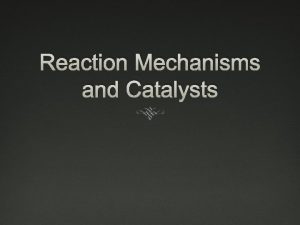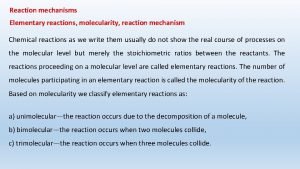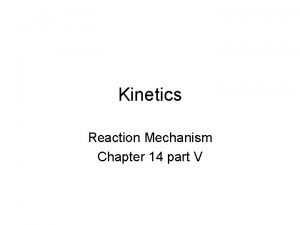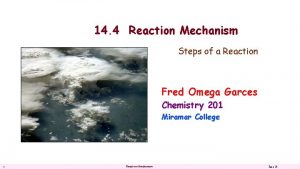Reaction Mechanism The reaction mechanism is the series








- Slides: 8

Reaction Mechanism The reaction mechanism is the series of elementary steps by which a chemical reaction occurs. ØThe sum of the elementary steps must give the overall balanced equation for the reaction Ø The mechanism must agree with the experimentally determined rate law

A classic nucleophilic substitution mechanism

Rate-Determining Step In a multi-step reaction, the slowest step is the rate-determining step. It therefore determines the rate of the reaction. The experimental rate law must agree with the rate-determining step

Identifying the Rate-Determining Step For the reaction: 2 H 2(g) + 2 NO(g) N 2(g) + 2 H 2 O(g) The experimental rate law is: R = k[NO]2[H 2] Which step in the reaction mechanism is the rate-determining (slowest) step? Step #1 H 2(g) + 2 NO(g) N 2 O(g) + H 2 O(g) Step #2 N 2 O(g) + H 2(g) N 2(g) + H 2 O(g) Step #1 agrees with the experimental rate law

Identifying Intermediates For the reaction: 2 H 2(g) + 2 NO(g) N 2(g) + 2 H 2 O(g) Which species in the reaction mechanism are intermediates (do not show up in the final, balanced equation? ) Step #1 H 2(g) + 2 NO(g) N 2 O(g) + H 2 O(g) Step #2 N 2 O(g) + H 2(g) N 2(g) + H 2 O(g) 2 H 2(g) + 2 NO(g) N 2(g) + 2 H 2 O(g) N 2 O(g) is an intermediate

Collision Model Key Idea: Molecules must collide to react. However, only a small fraction of collisions produces a reaction. Why?

Collision Model Collisions must have sufficient energy to produce the reaction (must equal or exceed the activation energy). Colliding particles must be correctly oriented to one another in order to produce a reaction.

Factors Affecting Rate Increasing temperature always increases the rate of a reaction. q Particles collide more frequently q Particles collide more energetically Increasing surface area increases the rate of a reaction Increasing Concentration USUALLY increases the rate of a reaction Presence of Catalysts, which lower the activation energy by providing alternate pathways















